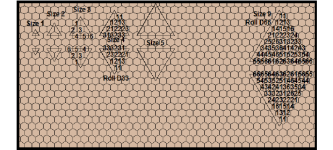I have the same dilemma, GoblinByte. I do disagree with dalthor that p. 432 is not to be used for randomly choosing hexes for terrain in a given triangle: it says "Locations for places (Triangles, World Hexes, Terrain Hexes, Local Hexes) and for the placement of terrain can be randomly selected." It seems to me it can be used both for randomly selecting where that ship crashed, or to place those 1D mountains in a particular world triangle. My apologies, dalthor, if I've misread you.
What the rules say in selecting a hex from a triangle is "If the Triangle is smaller than the roll, re-roll. If the Triangle is larger [a rare occurance, will only be if planet size is 12 or greater] break it into smaller Triangles and then randomly select."
This creates a problem practically. For a Size 8 world, after randomly selecting vertice A, B or C, there's only 12 available hexes from that corner (total of 36 hexes per Size 8 triangle; divide between the three vertices but replicate the centre hex location for all three vertices). That means of the 66 possibilities when you roll, only 12 will be valid, and so almost 5 times out of 6 when you roll that D66, you'll have to re-roll. It's time consuming. And you've got 20 triangles to fill! I'm patient and happy to put some work into a map, but there's a limit.
What I've done as I'm mapping worlds is to do up my own random selection for each size - see attached; sorry, I haven't included Size 8 yet. Generally I leave out one whole edge. If you don't do this, selection is biased towards triangle edges (they get more than one chance to get randomly selected terrain) and the clumps get pretty obvious once you've rolled 1D Mountains for every triangle.
Note that D33 means roll two D3's and use one for tens and the other for units the same as a D66. I use combinations of D3 (=D6 1-2=1, 3-4=2, 5-6=3), D2 (=D6 1-3=1, 4-6=2) and D6 to construct random selections that don't round to a perfect square of 6 (which is most of them). So, D26 will give you 12 evenly-selected possibilities, D36 will give you 18, etc.
Note that mountains that end up being covered by oceans become islands. This gives a pretty neat random distribution of islands.
There are other relatively minor problems with the rules as they stand. 1D mountains applies to all world sizes: this means smaller worlds are much more relatively mountainous than larger ones. Also, as chasms and precipices are placed after mountains, do they replace them or are they added to them? I'm thinking the latter; when you get to World Hex mapping, there's nothing wrong with drawing precipice lines across mountainous terrain as far as I can tell. Also, why so much wasteland all in one clump as World Hexes? And Cropland for Ag worlds is simply enormous, even for low-tech / low-population worlds. So some creative input is required to keep the results making sense in the context of a Word UWP; otherwise a population 6 (millions) agricultural low-tech world can end up with millions of square kilometres
per person to cultivate that can't be explained by automation.
One variation I am now definitely using is that when the rules call for placing Oceans by triangle, I randomly select a triangle and place a number of ocean hexes equal to the triangle size in a random or desired shape rather than just draw a line around the triangle and connect it to adjacent oceans. This gives a more natural feel if you decide to draw over your edges with coastlines.
Take a look at the Image Gallery here for some
great looking world maps generated by fractal mapping -
coliver988 in particular is doing some spectacular work. He's using
this fractal mapper and importing the result into GIMP.
Hope this is helpful.

